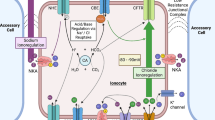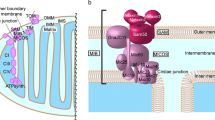Summary
Intercellular junctions between human kidney tubular cells were studied by the freeze-fracture technique.
The number of strands of the zonulae occludentes increased gradually from the proximal segment to the collecting tubule. Only one strand was visible in the proximal segment (in contrast to 2–4 strands of the neighbouring Bowman's capsule). In the thin segment 2–4 strands were revealed. In the distal segment 1–5 strands were present in the pars recta, 4–6 in the pars convoluta. The most extensive and complex zonulae occludentes were found in the collecting tubule. Gap junctions were seen only between proximal tubular cells.
The extent of the zonulae occludentes along the tubules in human kidney is very similar to that observed in the kidney tubules of other mammals. The findings accord well with electrophysiological measurements and with the results of tracer studies on experimental animals.
Similar content being viewed by others
References
Boulpaep, E. L.: Electrophysiological properties of the proximal tubule: importance of cellular and intercellular transport pathways. In: Electrophysiology of epithelial cells (G. Giebisch, ed.), p. 91–112. Symposia Medica Hoechst. Stuttgart: F. K. Schattauer 1971
Breathnach, A.: Application of the freeze-fracture replication technique to investigative dermatology. Brit. J. Derm. 88, 563–574 (1973)
Burg, M. B., Isaacson, L., Grantham, I., Orloff, I.: Electrical properties of isolated perfused rabbit renal tubules. Amer. J. Physiol. 215, 788–794 (1968)
Claude, P., Goodenough, D. A.: Fracture faces of zonulae occludentes from“tight” and “leaky” epithelia. J. Cell Biol. 58, 390–400 (1973)
Farquhar, M. G., Palade, G. E.: Junctional complexes in various epithelia. J. Cell Biol. 17, 375–412 (1963)
Frömter, E., Diamond, J.: Route of passive ion permeation in epithelia. Nature (Lond.) New Biol. 236, 9–13 (1972)
Giebisch, G.: Some electrical properties of mammalian distal tubules. In: Electrophysiology of epithelial cells (G. Giebisch, ed.), p. 149–152. Symposia Medica Hoechst. Stuttgart: F. K. Schattauer 1971
Giebisch, G., Windhager, E. E.: Electrolyte transport across renal tubular membranes. In: Handbook of physiology (I. Orloff and R. W. Berliner, eds.), p. 315–376, Section 8: Renal physiology. Washington, D. C.: Am. Physiol. Soc. 1973
Hegel, U., Frömter, E., Wick, T.: Der elektrische Wandwiderstand des proximalen Konvolutes der Rattenniere. Pflügers Arch. ges. Physiol. 294, 274–290 (1967)
Helman, S. I., Grantham, J. J., Burg, M. B.: Effect of vasopressin on electrical resistance of renal cortical collecting tubules. Amer. J. Physiol. 220, 1825–1832 (1971)
Kühn, K., Reale, E., Wermbter, G.: The glomeruli of the human and the rat kidney studied by freeze-fracturing. Cell Tiss. Res. 160, 177–191 (1975)
Leak, L. V.: Ultrastructure of proximale tubule cells in mouse kidney as revealed by freeze etching. J. Ultrastruct. Res. 25, 253–270 (1968)
Martinez-Palomo, A., Erlij, D.: The distribution of lanthanum in tight junctions of the kidney tubule. Pflügers Arch. 343, 267–272 (1973)
Maunsbach, A. B.: Ultrastructure of the proximal tubule. In: Handbook of physiology (I. Orloff and R. W. Berliner, eds.), p. 31–79, Section 8: Renal physiology. Washington, D. C.: Am. Physiol. Soc. 1973
McNutt, N. S., Hershberg, R. A., Weinstein, R. S.: Further observations on the occurrence of nexuses in benign and malignant human cervical epithelium. J. Cell Biol. 51, 805–825 (1971)
McNutt, N. S., Weinstein, R. S.: The ultrastructure of the nexus. A correlated thin-section and freeze-cleave study. J. Cell Biol. 47, 666–688 (1970)
McNutt, N. S., Weinstein, R. S.: Membrane ultrastructure at mammalian intercellular junctions. Progr. Biophys. Mol. Biol. 26, 45–101 (1973)
Pricam, C., Humbert, F., Perrelet, A., Orci, L.: A freeze-etch study of the tight junctions of the rat kidney tubules. Lab. Invest. 30, 286–291 (1974)
Rhodin, J. A. G.: Structure of the kidney. In: Diseases of the kidney (M. B. Strauss and L. G. Welt, eds.), p. 1–30. Boston: Little Brown and Company 1971
Ryser, M, A., Webber, W. A.: Cell junctions in Bowman's capsule in developing rat and human kidney. Cell Tiss. Res. 150, 399–407 (1974)
Schwartz, M. M., Venkatachalam, M. A.: Structural differences in thin limbs of Henle: Physiological implications. Kidney Int. 6, 193–208 (1974)
Staehelin, L. A., Mukherjee, T. M., Williams, A. W.: Freeze-etch appearance of the tight junctions in the epithelium of small and large intestine of mice. Protoplasma (Wien) 67, 165–184 (1969)
Thoenes, W.: Zellen in Exkretionsorganen. In: Grundlagen der Cytologie (G. C. Hirsch, H. Ruska, P. Sitte, Hrsg.), S. 647–665. Jena: Fischer Verlag 1973
Tisher, C. C., Yarger, W. E.: Lanthanum permeability of the tight junctions (zonula occludens) in the renal tubule of the rat. Kidney Int. 3, 238–250 (1973)
Trump, B. F., Bulger, R. E.: Morphology of the kidney. In: Structural basis of renal disease (E. L. Becker, ed.), p. 1–98. New York-Evanston-London: Hoeber Medical Division, Harper and Row 1968
Webber, W. A., Blackbourn, J.: The permeability of the parietal layer of Bowman's capsule. Lab. Invest. 25, 367–373 (1971)
Whittemburg, G., Rawlins, P. A.: Evidence of a paracellular pathway for ion flow in the kidney proximal tubule: Electron microscopic demonstration of lanthanum precipitate in the tight junction. Pflügers Arch. 330, 302–309 (1971)
Windhager, E. E.: Electrophysiological study of the renal papilla of golden hamsters. Amer. J. Physiol. 206, 694–700 (1964)
Wright, F.: Increasing magnitude of electrical potential along the renal distal tubule. Amer. J. Physiol. 220, 624–658 (1971)
Author information
Authors and Affiliations
Additional information
We are greatly indebted to Mrs. Dipl.-Ing. G. Wermbter and to Prof. K.H. Gertz (Division of Renal Physiology, Hannover Medical School) for their valuable criticism and discussion, to Prof. P. Kolle (Division of Urology, Hannover Medical School) and his colleague's who performed the needle biopsies. We also wish to thank Mr. H. Heidrich for his excellent technical assistance.
Rights and permissions
About this article
Cite this article
Kühn, K., Reale, E. Junctional complexes of the tubular cells in the human kidney as revealed with freeze-fracture. Cell Tissue Res. 160, 193–205 (1975). https://doi.org/10.1007/BF00220577
Received:
Accepted:
Issue Date:
DOI: https://doi.org/10.1007/BF00220577




